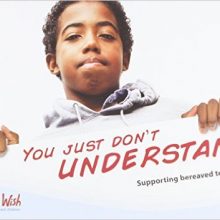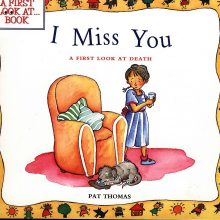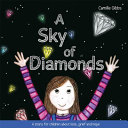Children’s grief reactions
Common Grief Reactions in Children and Young People
All children and young people will experience the death of somebody close to them in different ways. At SeeSaw we believe that, just as dying is a natural part of living, all grief reactions too are natural and normal responses. Children’s grief reactions will vary depending on the child’s age and stage of development, their character, and the existence of secure and supportive relationships with their caregivers.
Below are some common grief reactions for children and young people of all ages:
0-12 Months
Babies react to the sense of loss of the person who cares for them
- They react to smell and the way they are handled
- They will notice if once smiling faces at feed times become sad faces
- They may become more unsettled
- Sleeping and eating patterns may be affected
- They may become more tearful or clingy
1-3 Years
Toddlers will notice the absence of the person who has died without understanding what has happened
- They may repeatedly ask when the person is coming back as they will not understand the finality of death
- They will pick up the emotions of the adults around them
- They may express their emotions through changes in behaviour rather than language
- They may appear more anxious or become more clingy, especially with strangers or at bedtime
- They may become more aggressive in play or have more temper tantrums.
- They may show some regressive behaviours especially with toileting and sleep patterns
- They may ask the same questions repeatedly
3-5 Years
At this age, children will not understand the meaning of death, especially its finality, while at the same time using some of the correct language, giving the impression they understand what has happened.
- They may show signs of missing the person but may hop in and out of their sadness (‘Puddle Jumping’)
- They may ask the same questions repeatedly
- They may be clingy with a remaining carer and not want to engage with less familiar people
- They may act out in their play what has happened, especially if the death was the result of a car accident or illness, perhaps by playing doctors and nurses
- They may show some regressive behaviours
- They may have outbursts of emotions expressed as anger, shouting or tantrums
- They may show signs of increased anxiety and worries
- They may think they were the cause of the person dying – through something they said or did or by being told off before the death (‘Magical Thinking’)
5-9 Years
At this age children may:
- Show regression in behaviours
- Experience anxiety
- Display angry or aggressive behaviours
- Have nightmares
- Be more tearful than usual
- Experience ‘Magical thinking’ in which they may feel that something they did or said contributed to the death
- Act out
- Develop fears that other family members may die
- Develop separation anxiety
- Ask repeated questions about death or the person who has died
- ‘Puddle jump’ where they move quickly in and out of their sadness
- Experience real or imagined physical symptoms, such as headaches or stomach aches
9-12 Years
At this age, children usually understand the finality of death. They may:
- Develop fear of death for themselves or others
- Experience sadness
- Experience anxiety
- Feel anger
- Be tearful
- Display mood swings
- Experience real or imagined physical symptoms, such as headaches or stomach aches
- Question death and what happens after death
Adolescence
Teenagers may also experience a range of emotional, behavioural and physical reactions to grief They may experience feelings of:
- Anger
- Sadness
- Guilt
- Shame
- Relief
- Loneliness
- Fear
- Anxiety
- Frustration
- Confusion
- Denial
They may:
- Push themselves harder to achieve
- Try to step into the role of the person who has died
- Participate in, or escalate, harmful or risk-taking behaviours
- Skip school
- Withdraw from friends and family
- Lose interest in regular hobbies and activities
- Experience mood swings
- Have difficulty sleeping
- Eat more or less than usual
- Experience difficulty with concentration and organisation
Resources
Suggested Readings
Young people, death and the unfairness of everything
by Nick Luxmoore
Without opportunities to talk, young people’s anxieties about death can manifest themselves in all sorts of self-destructive and socially-destructive ways. In this book, Nick Luxmoore explores the problems that arise when death is not openly discussed with young people and offers advice about how best to allay concerns without having to pretend that there are easy answers.
The huge bag of worries
by Virginia Ironside
A compelling picture book which can be used as a spring board into what worries children today. The lively, comic-style pictures and the general nature of the worries make this excellent for any number of problems. The message of the book is clear—find someone who will listen and talk about your worries.
You just don’t understand: supporting bereaved teenagers
by Helen Mackinnon, Winston’s Wish publication
The transition from childhood to adulthood can be a challenging process at the best of times. This booklet aims to help you understand what is normal adolescent development, and to recognise the additional problems teenagers may face if someone important dies during these years.
A place in my heart
by Annette Aubrey
Andrew’s grandad has died, and Andrew is feeling very sad and confused. Explore with a child the difficult issue of bereavement as Andrew talks about his feelings with his mum and dad. From the ‘Understanding…’ series, these illustrated storybooks allow small children to get to grips with upsetting and bewildering situations that might be affecting them or people around them.
I miss you: a first look at death
by Pat Thomas
This reassuring picture book explores the difficult issue of death for young children. Children’s feelings and questions about this sensitive subject are looked at in a simple but realistic way. This book helps them to understand their loss and come to terms with it.
A Sky of Diamonds
by Camille Gibbs
When Mia learns that her mother has died, all the colour in her world changes to a dreary grey. She feels guilty, angry, sad and lost (sometimes all at once!), and she doesn’t know what to do to feel better. Little by little, with the help of her Dad, Mia learns how to cope with her difficult feelings. Together, they remember her mother by creating memory boxes, and they even get rid of anger by crazily sloshing paints and punching holes in newspapers! In the end, Mia finds her own, very special way of coping. When she feels sad or lonely, she looks up to the stars.
Sometimes Life Sucks
by Molly Carlile
Whether it’s the death of a grandparent, pet or school friend, a teen fatality, a peer with terminal illness, living without a mum or dad, or the death of a celebrity, like everyone else teenagers also struggle to come to terms with their shock and grief.
When a friend dies
by Dr Marilyn E Gootman
The death of a friend is a wrenching event for anyone at any age. Teenagers especially need help coping with this painful loss. This sensitive book answers questions grieving teens often have, like “How should I be acting?” “Is it wrong to go to parties and have fun?” and “What if I can’t handle my grief on my own?”The advice is gentle, non-preachy, and compassionate; the author has seen her own children suffer from the death of a friend, and she knows what teens go through. The revised edition includes new quotes from teens, new resources, and new insights into losing a friend through violence. Also recommended for parents and teachers of teens who have experienced a painful loss.
Feelings: Inside my heart and in my head
by Richard Jones and Libby Walden
A beautiful peep-through book to help children explore their feelings
The Invisible String
by Patrice Karst
Whether it’s a loved one far away, or a parent in the next room, this delightful book illustrates a new way to cope with something all children and parents confront sooner or later; a child’s fear of loneliness and separation. Here is a warm and delightful lesson teaching young and old that we aren’t ever really alone.
Wherever You Are My Love Will Find You
by Nancy Tillman
. . . I wanted you more than you’ll ever know,
so I sent love to follow wherever you go. . . .
Love is the greatest gift we have to give our children. It’s the one thing they can carry with them each and every day.
If love could take shape it might look something like these heartfelt words and images from the inimitable Nancy Tillman. Wherever You Are is a book to share with your loved ones, no matter how near or far, young or old, they are.















